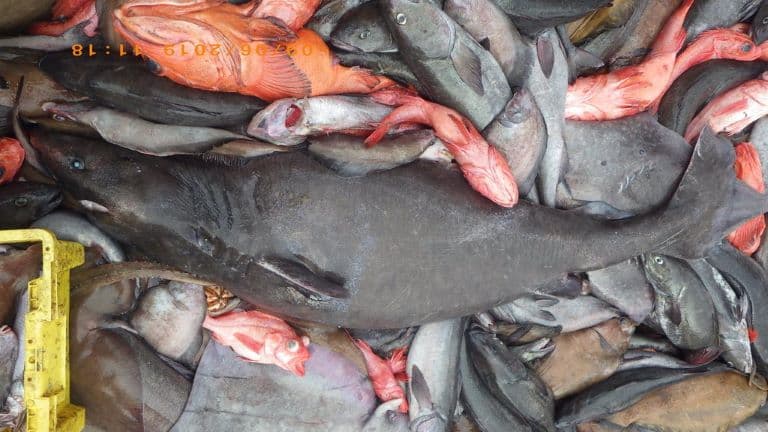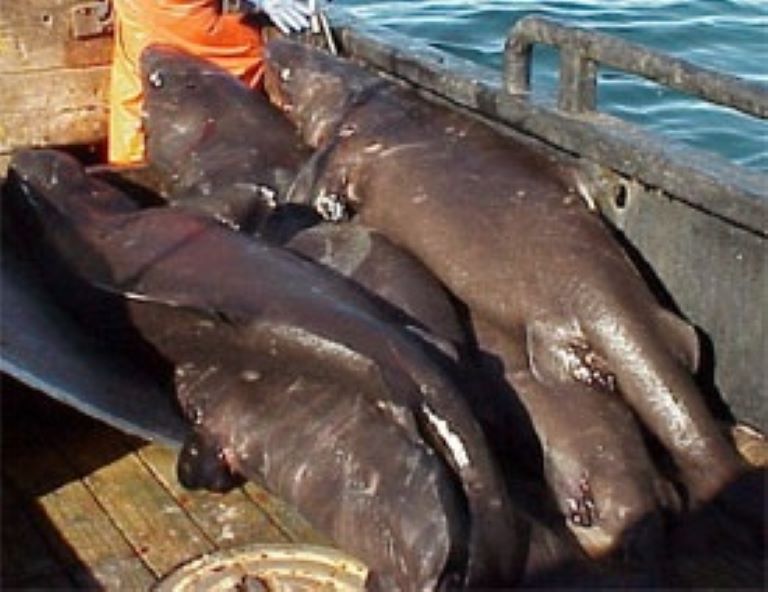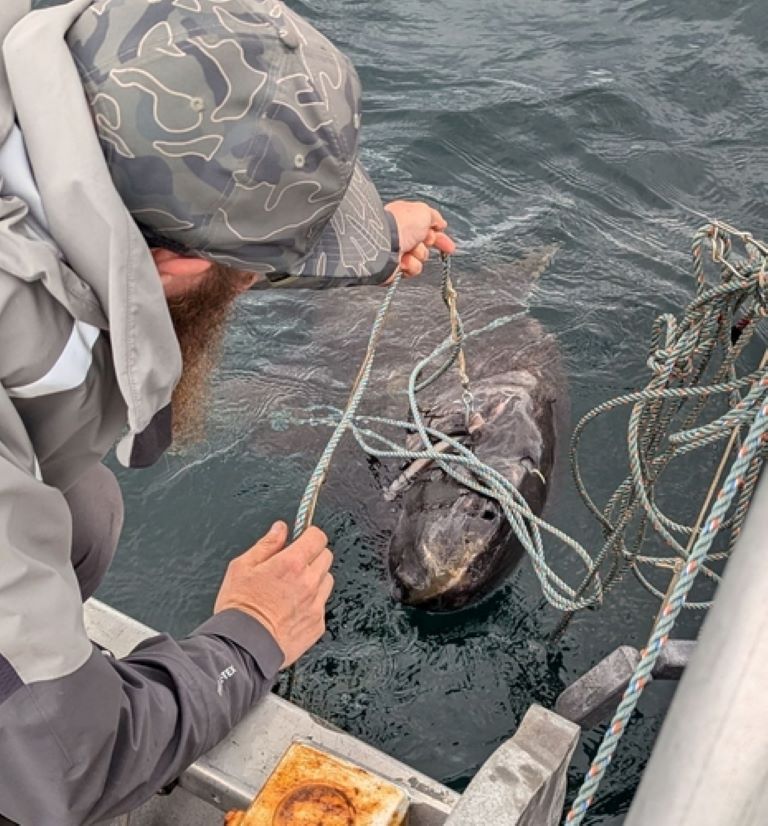Pacific Sleeper Shark Profile
As we’ve beaten into the ground already, the requiem sharks are the sharkiest sharks, but it still seems a bit rude to refer to the dogfish group of sharks as Squaliformes.
It means “shark-like”, which is technically accurate because they are true sharks, but a little condescending, nonetheless.
Among this group of freaks is a comfortable member: the sleeper shark. These are found all over the world, but one in particular spends a lot of time in the cold Pacific and Arctic regions and is named the Pacific sleeper shark.
Though, from its diet, we can tell there’s not much sleepy about it.

Pacific Sleeper Shark Facts Overview
| Habitat: | Deep water, marine |
| Location: | North Pacific, Arctic and temperate zones |
| Lifespan: | Likely 300 + |
| Size: | Largest known 4.4 m (14 ft), possibly up to 7 m (23 ft) long |
| Weight: | Heaviest 888 kg (1,958 lb) |
| Colour: | Grey |
| Diet: | Bottom-dwelling fish, crustaceans, giant squid, octopus, mammals |
| Predators: | Unknown, humans |
| Top Speed: | Slow |
| No. of Species: | 1 |
| Conservation Status: | Near Threatened (IUCN) |
Sleeper sharks are slow-moving, deep-sea sharks that grow to alarming size over a really long time and while considered to be docile and dopey to the point they’ve been named it at the family and genus level, their stomach tells a different story.
Sadly, these ancient giants are close to becoming threatened by the fishing industry and are in decline.
Interesting Pacific Sleeper Shark Facts
1. They’re Squaliforms
This order of sharks includes a lot of weirdos, including the rough sharks, lantern sharks and gulper sharks, and so it is that the sleeper sharks fit into the order nicely, as bizarre and elusive, shark-like creatures.
It almost seems as if the strangest-looking animals are relegated to the depths of the ocean, which should make it no surprise that this is where the Pacific sleeper lives.
They’re named for being sleepy, both at the family (Somniosidae) level and genus (Somniosus) levels. This has something to do with them moving around very slowly and spending a lot of time in the dark.

2. They’re deep-water sharks
The Pacific sleeper is a deep water specialist. It’s cold enough in the Arctic and North Pacific already, but at 2km down it’s a pretty stable 2- 2.5 C. And this is where the Pacific sleeper is often found, and one of the reasons we don’t know all that much about it.
One of the benefits of being in the deep is that, while cold, the temperature doesn’t change much at all.
The temperature of 2km deep water is more or less the same all over the globe, and this can allow animals to become very specialised.
But the Pacific sleeper isn’t restricted to this depth. In fact, it comes up all the way to the surface, which is a bit peculiar.
3. But they can surface
This shark species has been found from 0m (the surface) all the way down to 2008m below. It’s been found splashing about, stranded, in a tidal pool, where you’d more expect to find crabs and limpets.
It clearly has a preference for cold water, though, as in the Southernmost part of its range it appears to spend more time in the deep.
This is a bit of an elusive species, but tagging research has shown that at least some of them appear to do that creepy thing that deep water freaks often do: diurnal vertical migrations: emerging from the deep at night, when nobody’s watching and slinking back into the darkness as the sun comes up.
On the other hand, some seem to stay down there for good, which is a lot less creepy. 1

4. They’re slow
These sharks do almost everything at a relatively gentle pace. They mature slowly, they age slowly, and they live for a remarkably long time. as a result.
Some very clever molecular researchers estimate that this species can live up to and perhaps more than 300 years old, after taking several decades to reach sexual maturity.
But it’s not just ageing that they do slowly. Aside from the up and down movement, these sharks aren’t known for their locomotive abilities. They glide through the water very slowly, using minimal energy, and barely disturbing the water.
Still, this has been shown to work incredibly well for what is thought to be an ambush predator. 2
5. Don’t sleep on the sleeper
This species of shark would do well to be a scavenger, because being that cold and long-lived, it’s useful not to exert a lot of energy. And it’s thought that this is one feeding strategy the Pacific sleeper employs.
But it’s also said to be a predator, and the lack of turbulence it makes when it swims certainly would be an advantage in this strategy.
Some of the things that back up this idea are what can be found inside its stomach.
The stomachs of Pacific sleeper sharks have been found to contain octopus, shrimps, hermit crabs, salmon, and even harbour porpoises and young sea lions. But perhaps the most exciting find was the beaks of giant squids.
While it’s pleasing to assume that these sharks hunt the giant squid, it’s more likely they scavenge on their carcasses, as sperm whales – who actively hunt them – clearly wear the scars of their prey on their faces. And while sperm whales are much larger, the sleeper shark is nothing to scoff at. 3
6. They’re enormous
The largest shark, the whale shark, is about the size of a sperm whale. The second-largest, at least officially, is the basking shark, at around 12 metres – another plankton-feeding giant. Then, we come to the predators.
The largest white shark recorded reliably was a 6.4-metre female, though large holes in whale carcasses suggest they can grow to at least 8 metres.
This is all for perspective, because while the Pacific sleeper shark averages around 3.7 metres long, the largest on reliable record was 4.4 metres long, and they’re thought to be able to grow to 7m or more based on deep-sea photographs.
This makes it the fourth-largest shark in the world, and quite possibly the third, should a larger specimen be confirmed. 4
7. They’re brought up as bycatch
The industrial fishing industry is a mixed bag. Without it, we’d know relatively little about the deep, but unfortunately, the opportunity cost of this knowledge is the widespread eradication of anything bigger than a krill.
Most of what’s known about these deepwater sharks we owe to the industry that’s wiping them out, which isn’t a very good deal, really.
It’s a little-known fact that the majority of fish released after catching, even during recreational fishing, don’t recover and catch-release is a bit of a con, but for sleeper sharks, this mortality rate is estimated to be 100%. That means, throwing them back in does not improve the situation.
So far, they’re not quite on the brink, but the Pacific Sleeper sharks are classified as Near Threatened by the IUCN.
Pacific Sleeper Shark Fact-File Summary
Scientific Classification
| Kingdom: | Animalia |
| Phylum: | Chordata |
| Class: | Chondrichthyes |
| Order: | Squaliformes |
| Family: | Somniosidae |
| Genus: | Somniosus |
| Species: | pacificus |
Fact Sources & References
- “Pacific Sleeper Shark”, IUCN Red List.
- Laura E Timm (2023), “Molecular ecology of the sleeper shark subgenus Somniosus (Somniosus) reveals genetic homogeneity within species and lack of support for S. antarcticus”, Oxford Academic.
- (2018), “Episode 074: Colossal Squid and the Things That Eat Them”, Strange Animals Podcast.
- “Deep Sea: the Twilight Zone and Beyond Pacific Sleeper Shark”, Biology of Sharks and Raus.
